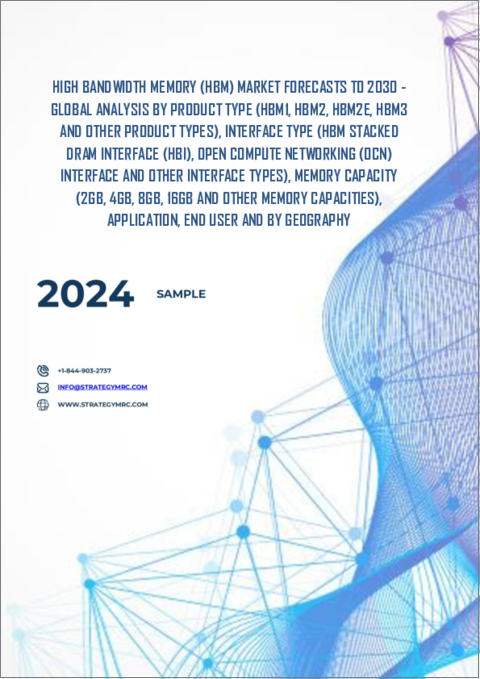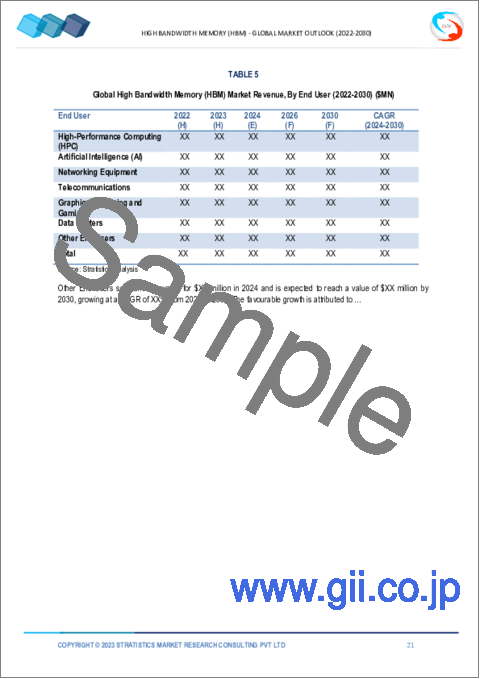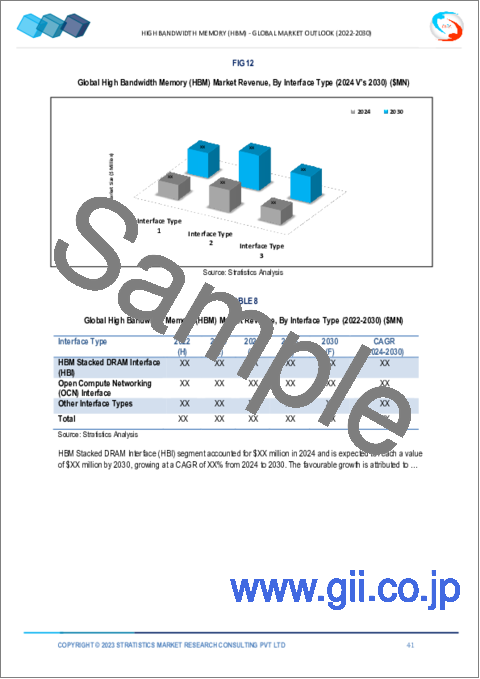|
|
市場調査レポート
商品コード
1530751
高帯域幅メモリ(HBM)の2030年市場予測: 製品タイプ、インターフェースタイプ、メモリ容量、用途、エンドユーザー、地域別の世界分析High Bandwidth Memory Market Forecasts to 2030 - Global Analysis By Product Type, Interface Type (HBM Stacked DRAM Interface, Open Compute Networking Interface and Other Interface Types), Memory Capacity, Application, End User and By Geography |
||||||
カスタマイズ可能
|
|||||||
| 高帯域幅メモリ(HBM)の2030年市場予測: 製品タイプ、インターフェースタイプ、メモリ容量、用途、エンドユーザー、地域別の世界分析 |
|
出版日: 2024年08月01日
発行: Stratistics Market Research Consulting
ページ情報: 英文 200+ Pages
納期: 2~3営業日
|
全表示
- 概要
- 図表
- 目次
Stratistics MRCによると、世界の高帯域幅メモリ(HBM)市場は2024年に25億米ドルを占め、予測期間中のCAGRは24.2%で成長し、2030年には92億米ドルに達すると予測されています。
高帯域幅メモリ(HBM)は、従来のDRAMと比較して大幅に高速なデータ転送速度を提供するコンピュータメモリの一種です。複数のDRAMダイを垂直に積み重ね、シリコン貫通電極(TSV)で接続することで実現します。HBMは主に、膨大なデータスループットが重要なハイパフォーマンス・コンピューティング・アプリケーション、グラフィックス・カード、AIアクセラレータで使用されます。消費電力を抑えながら大幅な帯域幅を提供できるHBMは、データセンター、科学シミュレーション、高度なゲームシステムなどの要求の厳しいタスクに最適です。
マイクロン・テクノロジーによると、同社の次期HBM3Eメモリは、競合製品と比較して1.2TB/秒以上の帯域幅と30%低い消費電力を提供します。マイクロンは2024年第2四半期に、NvidiaのH200 Tensor Core GPUで使用される容量24GBのHBM3Eチップを発売する予定です。
高まるハイパフォーマンス・コンピューティングのニーズ
ハイパフォーマンス・コンピューティング(HPC)に対するニーズの高まりは、より高速なデータ処理と強化されたメモリ帯域幅に対する需要の増加によって、高帯域幅メモリ(HBM)市場を牽引しています。卓越した速度と効率を実現するHBMの能力は、人工知能(AI)、データセンター、高度なグラフィックスなどのアプリケーションにとって極めて重要です。この需要は、ビッグデータ分析や複雑なシミュレーションの増加によってさらに促進され、さまざまな高性能コンピューティング環境でのHBMの採用を後押ししています。
限られた生産能力
高度な技術と精度を必要とする複雑な製造工程では、効率的に生産できるユニット数が制限されます。このボトルネックはHBMの可用性に影響し、潜在的な供給不足と価格の上昇を招き、さまざまな業界におけるHBMソリューションの普及を妨げる可能性があります。
HBM技術の進歩
HBM技術の進歩は、市場成長にとって大きな機会となります。HBM2Eや今後のHBM3などの技術革新は、より高い帯域幅、改善されたエネルギー効率、より大きなストレージ容量を提供し、次世代コンピューティング・アプリケーションの高まる需要を満たします。これらの技術的ブレークスルーは、AI、機械学習、仮想現実における性能向上を可能にし、新たな市場セグメントを開拓し、新たな高性能アプリケーションにおけるHBMの採用を促進します。
代替技術との競合
高帯域幅キャッシュ(HBC)、ハイブリッド・メモリ・キューブ(HMC)、従来のDRAMやGDDR技術の進歩といった新たなソリューションは、同等の性能をより低コストで提供できる可能性があります。これらの代替技術が進化すれば、コストと性能のトレードオフがHBMよりも有利な特定のアプリケーションで市場シェアを獲得できる可能性があります。さらに、新しいメモリアーキテクチャや材料の研究が進むと、ハイパフォーマンスコンピューティングアプリケーションにおけるHBMの地位に課題する破壊的な技術が生まれ、長期的な市場成長率や採用率が制限される可能性があります。
COVID-19の影響:
COVID-19の大流行は、サプライチェーンの問題と製造能力の低下により、当初HBMの生産を中断させました。しかし、デジタルトランスフォーメーションへの取り組みも加速し、ヘルスケア、リモートワーク、eコマースなどの分野でハイパフォーマンス・コンピューティング・ソリューションへの需要が高まった。これにより、データセンターの拡張やAIの実装が急増し、最終的に中長期的なHBMの需要を牽引することになった。
予測期間中、HBM2Eセグメントが最大となる見込み
HBM2Eセグメントは、旧世代と比較して高い帯域幅と改善された電力効率を提供する優れた性能特性により、市場を独占すると予想されます。HBM2Eは、AI、機械学習、高性能コンピューティングにおけるデータ集約型アプリケーションの需要の高まりに対応しています。容量と速度が向上したHBM2Eは、グラフィックス・プロセッシング・ユニット(GPU)やデータセンター・アクセラレータに最適です。このセグメントの成長は、5Gインフラ、自律走行車、高度分析などの最先端技術の採用によってさらに促進され、HBM2Eはさまざまな産業における高帯域幅メモリ要件に最適なソリューションとして位置付けられています。
予測期間中、16GBセグメントのCAGRが最も高くなる見込み
より大容量のメモリを必要とするデータ集約型アプリケーションの複雑化により、16GBセグメントのCAGRが最も高くなっています。この容量のスイートスポットは、多くのハイエンド・コンピューティング・アプリケーションにおいて、性能ニーズとコスト考慮のバランスが取れています。16GB HBMモジュールは、メモリ帯域幅と容量が極めて重要なAIトレーニング、科学シミュレーション、高度なグラフィックス・レンダリングにとって特に魅力的です。AIやビッグデータ解析を採用する業界が増えるにつれ、16GB HBMソリューションの需要は急増すると予想されます。
最大シェアの地域:
北米地域は、ハイパフォーマンス・コンピューティング、人工知能、データセンター産業での存在感が強いため、高帯域幅メモリ(HBM)市場を独占する立場にあります。同地域は、HBMアプリケーションの技術革新を推進する大手テクノロジー企業や研究機関を擁しています。AI、クラウドコンピューティング、高度分析への大規模な投資が、高帯域幅メモリ・ソリューションの需要をさらに高めています。北米は、最先端技術の開発におけるリーダーシップと、さまざまな分野でのHBMの早期導入により、世界のHBM導入と技術進歩の動向をリードし、圧倒的な市場地位を確立しています。
CAGRが最も高い地域:
アジア太平洋地域は、急速な工業化と技術インフラへの投資の増加により、高帯域幅メモリ(HBM)市場で最も高いCAGRを予測しています。この地域では半導体産業が成長しており、中国、日本、韓国などの国々で高性能コンピューティングの需要が高まっていることも、市場の成長を後押ししています。データセンターの拡大とAIおよびVRアプリケーションの進歩は、同地域でのHBM採用をさらに加速させる。
無料のカスタマイズ提供:
本レポートをご購読のお客様には、以下の無料カスタマイズオプションのいずれかをご利用いただけます:
- 企業プロファイル
- 追加市場プレイヤーの包括的プロファイリング(3社まで)
- 主要企業のSWOT分析(3社まで)
- 地域セグメンテーション
- 顧客の関心に応じた主要国の市場推計・予測・CAGR(注:フィージビリティチェックによる)
- 競合ベンチマーキング
- 製品ポートフォリオ、地理的プレゼンス、戦略的提携に基づく主要企業のベンチマーキング
目次
第1章 エグゼクティブサマリー
第2章 序文
- 概要
- ステークホルダー
- 調査範囲
- 調査手法
- データマイニング
- データ分析
- データ検証
- 調査アプローチ
- 調査情報源
- 1次調査情報源
- 2次調査情報源
- 前提条件
第3章 市場動向分析
- 促進要因
- 抑制要因
- 機会
- 脅威
- 製品分析
- 用途分析
- エンドユーザー分析
- 新興市場
- COVID-19の影響
第4章 ポーターのファイブフォース分析
- 供給企業の交渉力
- 買い手の交渉力
- 代替品の脅威
- 新規参入業者の脅威
- 競争企業間の敵対関係
第5章 世界の高帯域幅メモリ(HBM)市場:製品タイプ別
- HBM1
- HBM2
- HBM2E
- HBM3
- その他の製品タイプ
第6章 世界の高帯域幅メモリ(HBM)市場:インターフェースタイプ別
- HBMスタック DRAMインターフェース(HBI)
- オープンコンピューティングネットワーキング(OCN)インターフェース
- その他のインターフェースタイプ
第7章 世界の高帯域幅メモリ(HBM)市場:メモリ容量別
- 2GB
- 4GB
- 8GB
- 16GB
- その他のメモリ容量
第8章 世界の高帯域幅メモリ(HBM)市場:用途別
- グラフィックスプロセッシングユニット(GPU)
- 特定用途向け集積回路(ASIC)
- 中央処理装置(CPU)
- アクセラレーテッドプロセッシングユニット(APU)
- その他の用途
第9章 世界の高帯域幅メモリ(HBM)市場:エンドユーザー別
- 高性能コンピューティング(HPC)
- 人工知能(AI)
- ネットワーク機器
- 通信
- グラフィックレンダリングとゲーム
- データセンター
- その他のエンドユーザー
第10章 世界の高帯域幅メモリ(HBM)市場:地域別
- 北米
- 米国
- カナダ
- メキシコ
- 欧州
- ドイツ
- 英国
- イタリア
- フランス
- スペイン
- その他欧州
- アジア太平洋
- 日本
- 中国
- インド
- オーストラリア
- ニュージーランド
- 韓国
- その他アジア太平洋地域
- 南米
- アルゼンチン
- ブラジル
- チリ
- その他南米
- 中東・アフリカ
- サウジアラビア
- アラブ首長国連邦
- カタール
- 南アフリカ
- その他中東とアフリカ
第11章 主な発展
- 契約、パートナーシップ、コラボレーション、合弁事業
- 買収と合併
- 新製品発売
- 事業拡大
- その他の主要戦略
第12章 企業プロファイリング
- Samsung Electronics Co., Ltd.
- SK Hynix Inc.
- Micron Technology, Inc.
- Advanced Micro Devices, Inc.(AMD)
- NVIDIA Corporation
- Intel Corporation
- Xilinx, Inc.
- Fujitsu Limited
- IBM Corporation
- Broadcom Inc.
- MediaTek Inc.
- Renesas Electronics Corporation
- NXP Semiconductors N.V.
- Texas Instruments Incorporated
- Cadence Design Systems, Inc.
- Arm Holdings plc
- Marvell Technology Group Ltd.
- InnoGrit Corporation
List of Tables
- Table 1 Global High Bandwidth Memory (HBM) Market Outlook, By Region (2022-2030) ($MN)
- Table 2 Global High Bandwidth Memory (HBM) Market Outlook, By Component (2022-2030) ($MN)
- Table 3 Global High Bandwidth Memory (HBM) Market Outlook, By Hardware (2022-2030) ($MN)
- Table 4 Global High Bandwidth Memory (HBM) Market Outlook, By Base Stations (2022-2030) ($MN)
- Table 5 Global High Bandwidth Memory (HBM) Market Outlook, By Antennas (2022-2030) ($MN)
- Table 6 Global High Bandwidth Memory (HBM) Market Outlook, By Routers (2022-2030) ($MN)
- Table 7 Global High Bandwidth Memory (HBM) Market Outlook, By Switches (2022-2030) ($MN)
- Table 8 Global High Bandwidth Memory (HBM) Market Outlook, By Other Hardware (2022-2030) ($MN)
- Table 9 Global High Bandwidth Memory (HBM) Market Outlook, By Software (2022-2030) ($MN)
- Table 10 Global High Bandwidth Memory (HBM) Market Outlook, By Network Management Software (2022-2030) ($MN)
- Table 11 Global High Bandwidth Memory (HBM) Market Outlook, By Security Solutions (2022-2030) ($MN)
- Table 12 Global High Bandwidth Memory (HBM) Market Outlook, By Other Software (2022-2030) ($MN)
- Table 13 Global High Bandwidth Memory (HBM) Market Outlook, By Deployment Type (2022-2030) ($MN)
- Table 14 Global High Bandwidth Memory (HBM) Market Outlook, By On-premises (2022-2030) ($MN)
- Table 15 Global High Bandwidth Memory (HBM) Market Outlook, By Cloud-based (2022-2030) ($MN)
- Table 16 Global High Bandwidth Memory (HBM) Market Outlook, By Organization Size (2022-2030) ($MN)
- Table 17 Global High Bandwidth Memory (HBM) Market Outlook, By Small and Medium-sized Enterprises (SMEs) (2022-2030) ($MN)
- Table 18 Global High Bandwidth Memory (HBM) Market Outlook, By Large Enterprises (2022-2030) ($MN)
- Table 19 Global High Bandwidth Memory (HBM) Market Outlook, By Technology (2022-2030) ($MN)
- Table 20 Global High Bandwidth Memory (HBM) Market Outlook, By LTE (2022-2030) ($MN)
- Table 21 Global High Bandwidth Memory (HBM) Market Outlook, By 5G (2022-2030) ($MN)
- Table 22 Global High Bandwidth Memory (HBM) Market Outlook, By Wi-Fi (2022-2030) ($MN)
- Table 23 Global High Bandwidth Memory (HBM) Market Outlook, By Other Technologies (2022-2030) ($MN)
- Table 24 Global High Bandwidth Memory (HBM) Market Outlook, By Application (2022-2030) ($MN)
- Table 25 Global High Bandwidth Memory (HBM) Market Outlook, By Manufacturing (2022-2030) ($MN)
- Table 26 Global High Bandwidth Memory (HBM) Market Outlook, By Healthcare (2022-2030) ($MN)
- Table 27 Global High Bandwidth Memory (HBM) Market Outlook, By Transportation and Logistics (2022-2030) ($MN)
- Table 28 Global High Bandwidth Memory (HBM) Market Outlook, By Energy and Utilities (2022-2030) ($MN)
- Table 29 Global High Bandwidth Memory (HBM) Market Outlook, By Emergency Services (2022-2030) ($MN)
- Table 30 Global High Bandwidth Memory (HBM) Market Outlook, By Other Applications (2022-2030) ($MN)
Note: Tables for North America, Europe, APAC, South America, and Middle East & Africa Regions are also represented in the same manner as above.
According to Stratistics MRC, the Global High Bandwidth Memory (HBM) Market is accounted for $2.5 billion in 2024 and is expected to reach $9.2 billion by 2030 growing at a CAGR of 24.2% during the forecast period. High-bandwidth memory (HBM) is a type of computer memory that offers significantly faster data transfer rates compared to traditional DRAM. It achieves this by stacking multiple DRAM dies vertically and connecting them with through-silicon vias (TSVs). HBM is primarily used in high-performance computing applications, graphics cards, and AI accelerators where massive data throughput is crucial. Its ability to provide substantial bandwidth while consuming less power makes it ideal for demanding tasks in data centers, scientific simulations, and advanced gaming systems.
According to Micron Technology, their upcoming HBM3E memory will offer over 1.2 TB/s bandwidth and 30% lower power consumption compared to competing products. Micron plans to launch 24GB capacity HBM3E chips in Q2 2024 for use in Nvidia's H200 Tensor Core GPUs.
Market Dynamics:
Driver:
Growing need for high-performance computing
The growing need for high-performance computing (HPC) drives the High Bandwidth Memory (HBM) market by increasing demand for faster data processing and enhanced memory bandwidth. HBM's ability to deliver exceptional speed and efficiency is crucial for applications in artificial intelligence (AI), data centers, and advanced graphics. This demand is further fueled by the rise in big data analytics and complex simulations, pushing the adoption of HBM in various high-performance computing environments.
Restraint:
Limited production capacity
The complex manufacturing process, requiring advanced technology and precision, restricts the number of units that can be produced efficiently. This bottleneck affects the availability of HBM, leading to potential supply shortages and increased prices, which can hinder the widespread adoption of HBM solutions across different industries.
Opportunity:
Advancements in HBM technology
Advancements in HBM technology present significant opportunities for market growth. Innovations such as HBM2E and upcoming HBM3 offer higher bandwidth, improved energy efficiency, and greater storage capacity, meeting the rising demands of next-generation computing applications. These technological breakthroughs enable enhanced performance in AI, machine learning, and virtual reality, opening new market segments and driving the adoption of HBM in emerging high-performance applications.
Threat:
Competition from alternative technologies
Emerging solutions like High Bandwidth Cache (HBC), Hybrid Memory Cube (HMC), and advancements in traditional DRAM and GDDR technologies could potentially offer comparable performance at lower costs. As these alternatives evolve, they may capture market share in certain applications where the cost-performance trade-off favors them over HBM. Additionally, ongoing research into novel memory architectures and materials could lead to disruptive technologies that challenge HBM's position in high-performance computing applications, potentially limiting its long-term market growth and adoption rates.
Covid-19 Impact:
The COVID-19 pandemic initially disrupted HBM production due to supply chain issues and reduced manufacturing capacity. However, it also accelerated digital transformation efforts, increasing demand for high-performance computing solutions in sectors like healthcare, remote work, and e-commerce. This led to a surge in data center expansions and AI implementations, ultimately driving demand for HBM in the medium to long term.
The HBM2E segment is expected to be the largest during the forecast period
The HBM2E segment is expected to dominate the market due to its superior performance characteristics, offering higher bandwidth and improved power efficiency compared to previous generations. HBM2E addresses the growing demands of data-intensive applications in AI, machine learning, and high-performance computing. Its increased capacity and speed make it ideal for graphics processing units (GPUs) and data center accelerators. The segment's growth is further fueled by its adoption of cutting-edge technologies like 5G infrastructure, autonomous vehicles, and advanced analytics, positioning HBM2E as the go-to solution for high-bandwidth memory requirements in various industries.
The 16GB segment is expected to have the highest CAGR during the forecast period
The 16GB segment is experiencing the highest CAGR due to the increasing complexity of data-intensive applications requiring larger memory capacities. This capacity sweet spot balances performance needs with cost considerations for many high-end computing applications. The 16GB HBM modules are particularly attractive for AI training, scientific simulations, and advanced graphics rendering, where memory bandwidth and capacity are crucial. As more industries adopt AI and big data analytics, the demand for 16GB HBM solutions is expected to surge.
Region with largest share:
The North America region is positioned to dominate the High Bandwidth Memory (HBM) Market due to its strong presence in high-performance computing, artificial intelligence, and data center industries. The region hosts major technology companies and research institutions driving innovation in HBM applications. Substantial investments in AI, cloud computing, and advanced analytics further fuel demand for high-bandwidth memory solutions. North America's leadership in developing cutting-edge technologies and its early adoption of HBM in various sectors contribute to its dominant market position, setting trends for global HBM adoption and technological advancements.
Region with highest CAGR:
The Asia Pacific region anticipates the highest CAGR in the High Bandwidth Memory (HBM) market owing to rapid industrialization and increasing investments in technology infrastructure. The region's growing semiconductor industry, coupled with rising demand for high-performance computing in countries like China, Japan, and South Korea, fuels market growth. Expanding data centers and advancements in AI and VR applications further accelerate HBM adoption in the region.
Key players in the market
Some of the key players in High Bandwidth Memory (HBM) market include Samsung Electronics, SK Hynix, Micron Technology, AMD, NVIDIA, Intel, Xilinx, Fujitsu, IBM, Broadcom, MediaTek, Renesas Electronics, NXP Semiconductors, Texas Instruments, Cadence Design Systems, Arm Holdings, Marvell Technology Group, and InnoGrit Corporation.
Key Developments:
In February 2024, Samsung Electronics, a world leader in advanced memory technology announced that it has developed HBM3E 12H, the industry's first 12-stack HBM3E DRAM and the highest-capacity HBM product to date. Samsung's HBM3E 12H provides an all-time high bandwidth of up to 1,280 gigabytes per second (GB/s) and an industry-leading capacity of 36 gigabytes (GB). In comparison to the 8-stack HBM3 8H, both aspects have improved by more than 50%.
In December 2023, Nvidia has paid hundreds of millions of dollars in advance to SK Hynix and Micron to ensure a stable supply of High Bandwidth Memory (HBM). Recently, Samsung Electronics completed product testing and signed an HBM product supply contract with Nvidia. According to industry sources cited by Chosun Biz, SK Hynix, and Micron each received between KRW700 billion and KRW1 trillion (approximately US$540 million to US$770 million) in advance payments from Nvidia for the supply of advanced memory products. Although the details are not disclosed, the industry believes this is a measure by Nvidia to secure the supply of HBM3e for its new GPU products in 2024.
In November 2023, Nvidia announced the H200 and GH200 product line at Supercomputing 23 this morning. These are the most powerful chips Nvidia has ever created, building on the existing Hopper H100 architecture but adding more memory and more compute. These are set to power the future generation of AI supercomputers, with over 200 exaflops of AI compute set to come online during 2024.
Product Types Covered:
- HBM1
- HBM2
- HBM2E
- HBM3
- Other Product Types
Interface Types Covered:
- HBM Stacked DRAM Interface (HBI)
- Open Compute Networking (OCN) Interface
- Other Interface Types
Memory Capacities Covered:
- 2GB
- 4GB
- 8GB
- 16GB
- Other Memory Capacities
Applications Covered:
- Graphics Processing Unit (GPU)
- Application-Specific Integrated Circuit (ASIC)
- Central Processing Unit (CPU)
- Accelerated Processing Unit (APU)
- Other Applications
End Users Covered:
- High-Performance Computing (HPC)
- Artificial Intelligence (AI)
- Networking Equipment
- Telecommunications
- Graphics Rendering and Gaming
- Data Centers
- Other End Users
Regions Covered:
- North America
- US
- Canada
- Mexico
- Europe
- Germany
- UK
- Italy
- France
- Spain
- Rest of Europe
- Asia Pacific
- Japan
- China
- India
- Australia
- New Zealand
- South Korea
- Rest of Asia Pacific
- South America
- Argentina
- Brazil
- Chile
- Rest of South America
- Middle East & Africa
- Saudi Arabia
- UAE
- Qatar
- South Africa
- Rest of Middle East & Africa
What our report offers:
- Market share assessments for the regional and country-level segments
- Strategic recommendations for the new entrants
- Covers Market data for the years 2022, 2023, 2024, 2026, and 2030
- Market Trends (Drivers, Constraints, Opportunities, Threats, Challenges, Investment Opportunities, and recommendations)
- Strategic recommendations in key business segments based on the market estimations
- Competitive landscaping mapping the key common trends
- Company profiling with detailed strategies, financials, and recent developments
- Supply chain trends mapping the latest technological advancements
Free Customization Offerings:
All the customers of this report will be entitled to receive one of the following free customization options:
- Company Profiling
- Comprehensive profiling of additional market players (up to 3)
- SWOT Analysis of key players (up to 3)
- Regional Segmentation
- Market estimations, Forecasts and CAGR of any prominent country as per the client's interest (Note: Depends on feasibility check)
- Competitive Benchmarking
- Benchmarking of key players based on product portfolio, geographical presence, and strategic alliances
Table of Contents
1 Executive Summary
2 Preface
- 2.1 Abstract
- 2.2 Stake Holders
- 2.3 Research Scope
- 2.4 Research Methodology
- 2.4.1 Data Mining
- 2.4.2 Data Analysis
- 2.4.3 Data Validation
- 2.4.4 Research Approach
- 2.5 Research Sources
- 2.5.1 Primary Research Sources
- 2.5.2 Secondary Research Sources
- 2.5.3 Assumptions
3 Market Trend Analysis
- 3.1 Introduction
- 3.2 Drivers
- 3.3 Restraints
- 3.4 Opportunities
- 3.5 Threats
- 3.6 Product Analysis
- 3.7 Application Analysis
- 3.8 End User Analysis
- 3.9 Emerging Markets
- 3.10 Impact of Covid-19
4 Porters Five Force Analysis
- 4.1 Bargaining power of suppliers
- 4.2 Bargaining power of buyers
- 4.3 Threat of substitutes
- 4.4 Threat of new entrants
- 4.5 Competitive rivalry
5 Global High Bandwidth Memory (HBM) Market, By Product Type
- 5.1 Introduction
- 5.2 HBM1
- 5.3 HBM2
- 5.4 HBM2E
- 5.5 HBM3
- 5.6 Other Product Types
6 Global High Bandwidth Memory (HBM) Market, By Interface Type
- 6.1 Introduction
- 6.2 HBM Stacked DRAM Interface (HBI)
- 6.3 Open Compute Networking (OCN) Interface
- 6.4 Other Interface Types
7 Global High Bandwidth Memory (HBM) Market, By Memory Capacity
- 7.1 Introduction
- 7.2 2GB
- 7.3 4GB
- 7.4 8GB
- 7.5 16GB
- 7.6 Other Memory Capacities
8 Global High Bandwidth Memory (HBM) Market, By Application
- 8.1 Introduction
- 8.2 Graphics Processing Unit (GPU)
- 8.3 Application-Specific Integrated Circuit (ASIC)
- 8.4 Central Processing Unit (CPU)
- 8.5 Accelerated Processing Unit (APU)
- 8.6 Other Applications
9 Global High Bandwidth Memory (HBM) Market, By End User
- 9.1 Introduction
- 9.2 High-Performance Computing (HPC)
- 9.3 Artificial Intelligence (AI)
- 9.4 Networking Equipment
- 9.5 Telecommunications
- 9.6 Graphics Rendering and Gaming
- 9.7 Data Centers
- 9.8 Other End Users
10 Global High Bandwidth Memory (HBM) Market, By Geography
- 10.1 Introduction
- 10.2 North America
- 10.2.1 US
- 10.2.2 Canada
- 10.2.3 Mexico
- 10.3 Europe
- 10.3.1 Germany
- 10.3.2 UK
- 10.3.3 Italy
- 10.3.4 France
- 10.3.5 Spain
- 10.3.6 Rest of Europe
- 10.4 Asia Pacific
- 10.4.1 Japan
- 10.4.2 China
- 10.4.3 India
- 10.4.4 Australia
- 10.4.5 New Zealand
- 10.4.6 South Korea
- 10.4.7 Rest of Asia Pacific
- 10.5 South America
- 10.5.1 Argentina
- 10.5.2 Brazil
- 10.5.3 Chile
- 10.5.4 Rest of South America
- 10.6 Middle East & Africa
- 10.6.1 Saudi Arabia
- 10.6.2 UAE
- 10.6.3 Qatar
- 10.6.4 South Africa
- 10.6.5 Rest of Middle East & Africa
11 Key Developments
- 11.1 Agreements, Partnerships, Collaborations and Joint Ventures
- 11.2 Acquisitions & Mergers
- 11.3 New Product Launch
- 11.4 Expansions
- 11.5 Other Key Strategies
12 Company Profiling
- 12.1 Samsung Electronics Co., Ltd.
- 12.2 SK Hynix Inc.
- 12.3 Micron Technology, Inc.
- 12.4 Advanced Micro Devices, Inc. (AMD)
- 12.5 NVIDIA Corporation
- 12.6 Intel Corporation
- 12.7 Xilinx, Inc.
- 12.8 Fujitsu Limited
- 12.9 IBM Corporation
- 12.10 Broadcom Inc.
- 12.11 MediaTek Inc.
- 12.12 Renesas Electronics Corporation
- 12.13 NXP Semiconductors N.V.
- 12.14 Texas Instruments Incorporated
- 12.15 Cadence Design Systems, Inc.
- 12.16 Arm Holdings plc
- 12.17 Marvell Technology Group Ltd.
- 12.18 InnoGrit Corporation





